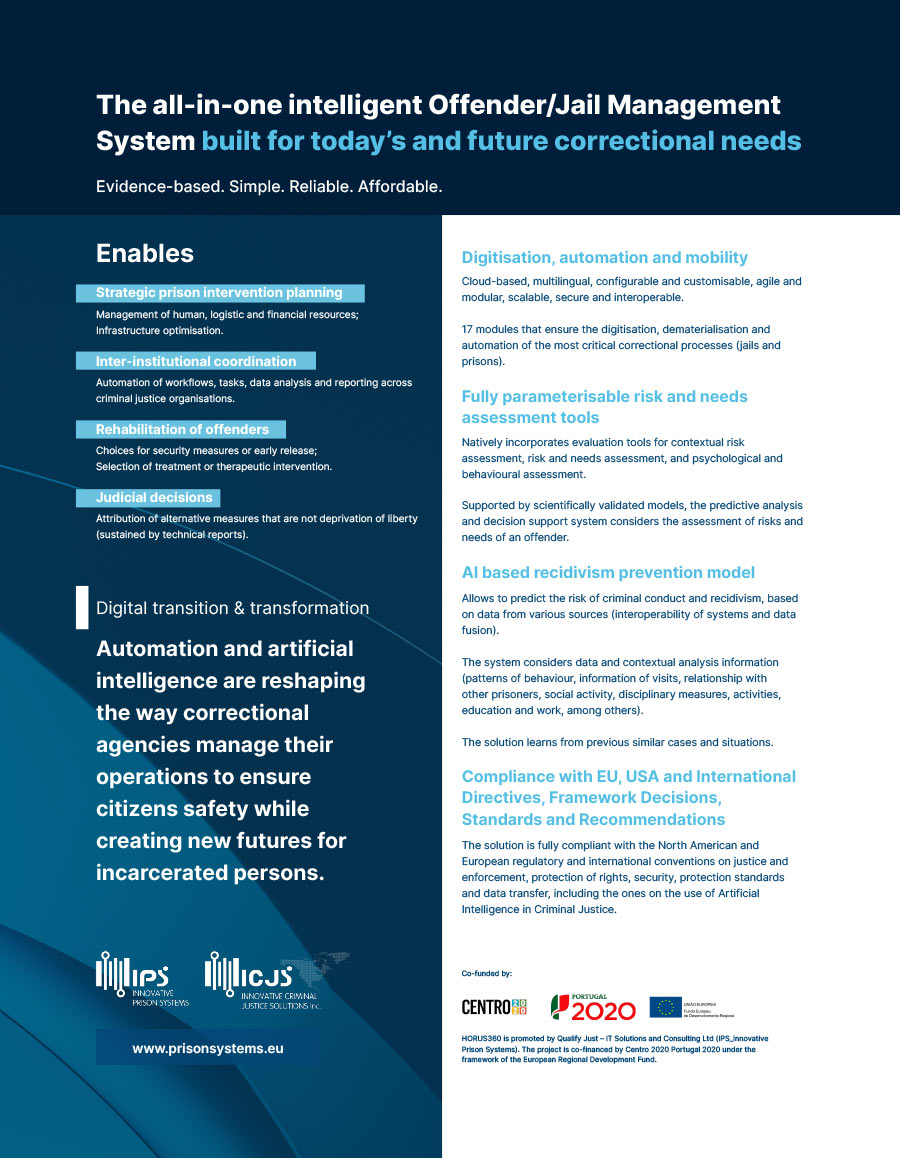Article
Pedro das Neves
Organised crime, prison groups or gangs, corruption, drug and weapons trafficking or other illicit goods, radicalisation and violent extremism are words that describe some of the threats that can undermine the security of the prison system, putting prison staff, inmates, and society at risk. Prison systems are faced with a dangerous prison population that is becoming increasingly diverse and difficult to manage. Groups that threaten security, including foreign or domestic criminal groups, gangs, as well as extremist, terrorist, supremacist and other hate cults and organisations, become of particular concern in security reports.
In many countries, contemporary prison gangs present new challenges. They have evolved from small predatory groups into sophisticated criminal organisations with the capacity to organise crimes on the outside that radically alter patterns of criminal violence and, in the extreme, hold governments hostage to debilitating and orchestrated violence and disruption (as we see in some Latin American countries, in the MENA region, and other regions around the world).
Prison administrations struggle to control the introduction of prohibited objects or illicit substances. These can enter an institution through a variety of routes; are often difficult to detect; feed the black-market economy within the institution; and ultimately, undermine the security of the institution.
Contraband in prisons includes illegal items, such as drugs and weapons, or prohibited items such as mobile phones. Prison staff must be able to detect and seize these items quickly to prevent drug abuse, violence, and the commission of further crime. Drugs and weapons pose a particular risk in prison settings, where there is a high potential for violence and drug abuse.
Beyond the violence associated with the control of drug smuggling and trafficking groups, the presence of drugs can hamper rehabilitation efforts. Mobile phones have been described as the most pressing concern of many prison administrations; these devices pose a significant threat not only to institutional security, but to public safety in general.
In some countries, inmates have used mobile phones to plan threats and attacks on witnesses in the community, escapes, attacks on prison staff and institutional unrest. In every country, thousands or tens of thousands of contraband mobile phones are confiscated each year, representing only a fraction of the total number, as many devices are not found and remain in circulation.

Violent extremism in prisons
These individual factors, combined with other institutional and social factors that characterise the prison environment (e.g., overcrowding, deprivation, violence, group dynamics, desire for protection and belonging), are generally accepted as the roots of radicalisation (Brandon, 2009b; Hamm, 2011; Mulcahy, Merrington and Bell, 2013; Silke and Veldhuis, 2017). An effective surveillance approach is essential to identify inmates and activities that may pose risks to the security of the prison or to society.

Dynamic Security and Prison Intelligence
The challenge for prison administrations is therefore to ensure that measures are in place to prevent, detect and disrupt radicalisation and violent extremism (UNODC, 2016), ensuring that the necessary processes and procedures are in place – including internal intelligence and inter-agency cooperation mechanisms – and that staff are carefully selected, supported, and trained.
Can prison intelligence be used to counter these threats?
However, the stakes are high. The spread of extremism and the tentacles of organised crime, if left unchecked within prison systems, pose significant threats that can ripple through societies. Harnessing the power of prison intelligence is not just a matter of improving security within prison walls; it’s about safeguarding the very fabric of our societies from threats that lurk in the shadows. The need for effective prison intelligence has never been more pressing.
How is the prison intelligence function structured in your organisation?
We are sure that this is a question that keeps you awake.
References
Brandon, J. (2009). Unlocking al–Qaeda: Islamist Extremism in British Prisons. London: Quilliam. Central Intelligence Agency (2002). Terrorists: Recruiting and operating behind bars.
Cilluffo, F., Saathoff, G., Lane, J., Cardash, S., Magarik, J., Whitehead, A., Raynor, J., Bogis, A., & Lohr, G. (2006). Out of the shadows: Getting ahead of prisoner radicalisation. A Special Report by the Homeland Security Policy Institute at The George Washington University and the Critical Incident Analysis Group at The University of Virginia. Washington, DC: The George Washington University Press.
Drake, D. (2008). Staff and order in prisons. In J. Bennett, B. Crewe, A. Wahidin (Eds.), Understanding prison staff (pp. 153-167). Devon: Willan Publishing.
Hamm, M. (2012). Prisoner Radicalization and Sacred Terrorism: A Life-Course Perspective. In R. Rosenfeld, K. Quinet and C. Garcia (Eds.) Contemporary Issues in Criminological Theory and Research: The Role of Social Institutions—Papers from the American Society of Criminology 2010 Conference (pp.173-204). Belmont, CA: Wadsworth.
Her Majesty’s Government (2013). Tackling extremism in the UK: Report from the Prime Minister’s Task Force on tackling radicalisation and extremism.
Martins, Bruno Oliveira & Monika Ziegler (2018) Counter-Radicalization as Counter-Terrorism: The European Union Case, in Expressions of Radicalization: Global Politics, Processes and Practices. Basingstoke: Palgrave (321–352).
Mulcahy, E., Merrington, S., & Bell, P. (2013). The radicalization of prison inmates: Exploring recruitment, religion and prisoner vulnerability. Journal of Human Security, 9, 4–14.
Neumann, P. (2010). Prisons and Terrorism: Radicalisation and Deradicalisation in 15 countries. London: International Centre for the Study of Radicalisation and Political Violence [ICSR].
Novo, J.; das Neves, Pedro (2021). Inteligencia en los sistemas penitenciarios
(identificación, prevención y gestión de amenazas). Diploma de Experto en Prevención y Gestión de la Seguridad Penitenciaria. UNED, Madrid, Spain.
Radicalisation Awareness Network, the Working Group on Prison and Probation [RAN P&P]
(2016a). Dealing with radicalisation in a prison and probation context. RAN P&P practitioners working paper.
Silke, A., & Veldhuis, T. (2017). Countering violent extremism in prisons: A review of key recent research and critical research gaps. Perspectives on Terrorism, 11(5), 2-11.
Van Heelsum, A., & Vermeulen, F. (2018). Cities’ policies: The work of European cities to counter Muslim radicalisation. Journal of International Migration and Integration, 19(1), 161-179.
United Nations Office on Drugs and Crime [UNODC] (2017). The United Nations Convention against Corruption. Handbook on Anti-Corruption Measures in Prisons. Criminal Justice Handbook Series. Vienna: United Nations.
United Nations Office on Drugs and Crime [UNODC] (2016). Preventing radicalisation to violent extremism in prison. In UNODC (Ed.), Handbook on the Management of Violent Extremist Prisoners and the Prevention of Radicalisation to Violence in Prisons (pp. 107-118). Vienna: United Nations Office Press.
United Nations Office on Drugs and Crime [UNODC] (2015). Handbook on dynamic security and prison intelligence. New York: United Nations.
United Nations Office on Drugs and Crime [UNODC] (2011). Criminal Intelligence – Manual for Analysts. New York: United Nations.

Pedro das Neves has experience in various European, Central Asian, Middle Eastern and Latin American countries in preventing and fighting organised crime and extremism. Pedro is CEO of IPS Innovative Prison Systems and ICJS Innovative Criminal Justice Solutions Inc, a board director of the International Corrections and Prisons Association (ICPA) and editor of the JUSTICE TRENDS Magazine. He is a lecturer in Intelligence in Penitentiary Systems (identification, prevention, and management of threats) in the Prevention and Management of Penitentiary Security Master Program of UNED University, a joint program of UNED and the General Secretary of Penitentiary Institutions in Spain.




